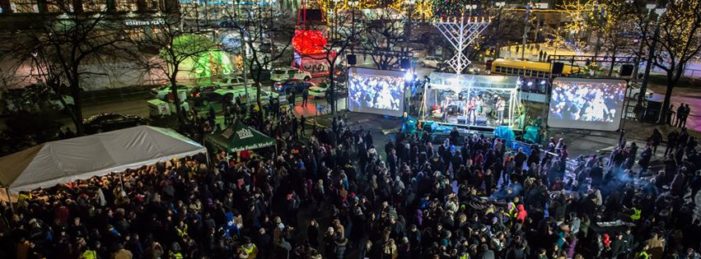Detroit is a place where people of all ages, backgrounds and faiths can come together and celebrate the holidays and learn from one another.
One of the best places to do that is at Campus Martius for the 7th annual Menorah in the D lighting ceremony on Tuesday, December 12. That’s the first day of the eight-day celebration of Hanukkah.
It all starts at 5:30 p.m. with entertainment and refreshments. The Pistons Extreme Team performance starts promptly at 5:30 p.m. so don’t be late.
The lighting of the 26-ft. menorah is at 6:00 p.m. The menorah was designed and built by artists (and brothers) Erik Nordin and Israel Nordin of Detroit Design Center in Corktown. There will be greetings from community leaders, dignitaries and Detroit Pistons celebrities and live music.
Before that, besides the Pistons Extreme Team, you can also enjoy:
- Marshmallow roasting pit
- Strolling entertainment
- Face painting
- Chanukah Gelt for the children
- Glow in the dark glasses
- Balloon sculpting
- Complementary Snack Bar including KIND bars, sufganiyot, hot soup and Roasting Plant coffee
- Kosher food truck
- Dancing dreidels & dreidel mascot
- Mitzvah station
- Horse-Drawn Carriage Rides available after 6 p.m.
- Limited edition Menorah in the D sweatshirts available for purchase
Here’s a little history about the menorah, according to the Jewish Art website.
It begins with the Biblical artisan, Bezalel, who created the first six-branched lamp for use in the First Temple. It is described in the book of Exodus and the biblical Talmud and was made from one solid block of pure gold.
 The First Temple was built by King Solomon in 1000 B.C.E. and held 10 menorahs. They were there for 400 years until 586 B.C.E, when Nebuchadnetzar, king of Babylon, destroyed the temple and all it contained.
The First Temple was built by King Solomon in 1000 B.C.E. and held 10 menorahs. They were there for 400 years until 586 B.C.E, when Nebuchadnetzar, king of Babylon, destroyed the temple and all it contained.
The Second Temple was built 70 years later and a new menorah was created and placed inside. This one had seven branches and is the variation used today. That temple was stood for 400 years, until 70 B.C.E when the Romans army destroyed it
In 167 B.C.E, the Jews, led by Mattathias the Hasmonean and his son, Judah Maccabee, revolted against the Greeks, who controlled the land and had desecrated the temple. Mattatias died in the first year of the three-year revolt and his son Judah Maccabee took charge of the army.
The Jews were outnumbered, had less ammunition, but were determined and they defeated the Greek army.
When Judah Maccabee and his soldiers went to the temple they found out many things were missing or broken, including the golden menorah. They repaired and purified the temple to make it ready for a dedication ceremony. That required lighting the great lamp, or menorah.
Unfortunately, they found only a small flask with enough oil to produce light for a single day. Then a miracle happened. That small bit of oil lasted for eight days, giving them enough time to obtain new oil to keep the menorah lit. Hanukkah, the festival of lights, commemorates that miracle.
The Hanukkah menorah therefore has eight main branches to commemorate the oil plus a raised ninth lamp set apart as the shamash (servant) light, which is used to light the other candles.
In the years since its inception, the “Menorah in the D” has become a welcome yearly event for Jews and gentiles alike in metro Detroit. It is hosted by The Shul in partnership with NEXTGen from the Jewish Federation of Metropolitan Detroit and Chabad in the “D”. It is co-sponsored by Quicken Loans and other corporate sponsors.


